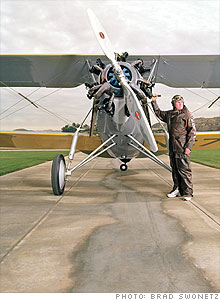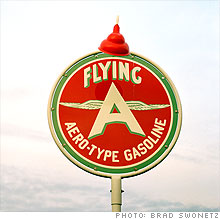Barnstorming in antique aircraft
An entrepreneur's vintage plane collection celebrates the early days of flight.
 |
| Bill Allen readies for takeoff. |
 |
| Part of Allen's collection: Vintage flight helmets |
 |
| A vintage sign, another collector's item that Allen prizes. |
EL CAJON, CALIF. (Fortune Small Business) -- Wearing an antique leather flight suit and sneakers, Bill Allen inserts a steel crank into the cowling of his 1930 Stearman biplane and leans his weight against the handle. The machine emits a faint whirling sound that grows in pitch until it blares like an air-raid siren. Allen steps back and dashes around the double wingtip. Clambering up the steps to the fuselage, he swings into the tiny cockpit.
"Clear prop!" he shouts, and the great radial engine answers: Clacketa-clacketa-clacketa. The prop spins, and the engine clatters and clangs until, finally, the ignition catches. The whole plane rocks, sending a gust of wind coursing through the wing struts as Allen sits in the cockpit, a mad grin on his face.
For a half-century this 62-year-old real estate investor has pursued his obsession with the earliest days of manned flight. Allen's Stearman, winner of a dozen gold medals at historical-aircraft shows around the country, is one highlight of a collection that fills a 17,000-foot custom-built hangar at San Diego's Gillespie Field. Allen's trove includes early aviation posters, weather-beaten propellers and even a mangled fragment of the Hindenburg -- the latter a poignant reminder that his passion is not without risk.
"I do worry about him, believe me," says his wife, Claudia.
Allen's devotion is remarkable, but it's hardly unusual in the rarefied subculture of aeronautical enthusiasts. Like all collectors, aviation fanatics revel in arcana, but they differ from, say, automobile collectors in that few people can operate vintage planes. Active licensed pilots make up just 0.2% of the American public; even fewer are wealthy enough to collect and fly such historical artifacts.
"They're all the same type of spirit," says Steve Hinton, president of the Planes of Fame aircraft museum in Chino, Calif. "They love history, machinery and airplanes. And they love to fly."
The high point of the aviation community's year is a fly-in hosted every July by the Experimental Aircraft Association in Oshkosh, Wis., when more than 10,000 planes converge for a weeklong festival.
The flying bug struck Allen early. His family owned two luxurious Southern California resorts, La Valencia Hotel in La Jolla and the Crystal Pier Hotel in Pacific Beach. The Allens had strong ties to the aviation industry. Friends included Jimmy Doolittle, leader of the first WWII air raid against Japan, and Charlie Willard, the fourth person ever to be issued a pilot's license in the United States. Allen's uncle, Captain Frederick M. Trapnell, was founding director of the Navy's test pilot school in Patuxent River, Md.
Allen first flew at the age of nine, when a family friend took him for a spin in a Cessna 170. As a child he collected models, propellers and aviation books. He became a collector in earnest as an Arizona State University undergraduate in the mid-1960s, after a fellow student sold him a set of aviation medals for $600. He bought his first airplane in 1973 and gradually amassed a seven-plane fleet that now includes a 1941 Stearman PT-17 (once owned by Steve McQueen) and the world's only airworthy F4B-1, a 1929 model that happens to be the last biplane the U.S. Navy ever commissioned for combat.
Allen's collection doubles as his personal museum. Vintage flight helmets fill a glass case near a wall covered with antique wooden propellers. He owns a pilot's license signed by Orville Wright and a flight bag that belonged to Howard Hughes. He even displays a gas can used to refill the Spirit of St. Louis, the legendary plane Charles Lindbergh flew across the Atlantic in 1927. When Allen started collecting, few saw much value in the artifacts he craved, but their prices have soared with the passage of time.
"The market has just gone crazy," he says. "Posters that I paid a thousand bucks for in the early '80s are now selling for $12,000."
Allen has logged more than 5,500 hours in the air, including more than 2,000 in antique planes. Since 1982 he has made several cross-country barnstorming trips, touching down in farmers' fields and giving short rides for a small fee. Once he set off on a flight in a 1929 Travel Air that had belonged to pioneering aviatrix Louise Thaden. A few days later the phone rang at the Allen residence in San Diego. Claudia answered. It was her husband; he needed a red-tagged carburetor.
"Why?" she asked. "Where are you?"
"I'm in Oklahoma," he replied. "The engine stopped, but I managed to land at an airport." Recalls Claudia: "I about had a cow."
Such scrapes are far from rare. A few years ago Allen was hand-propping an airplane -- starting the engine by turning the propeller -- when the plane broke free of the rope that held it in place. As it lurched forward, the spinning prop knocked Allen out, then struck a companion, breaking his sternum. Compared with some of his friends, though, Allen feels lucky.
"We've had so many friends killed," he says. "We lost seven in one year."
The incident that shook him up the most, however, wasn't an accident at all. In 2004 a stranger contacted Allen and asked him to take his 88-year-old father, a former Stearman instructor and WWII veteran who had terminal cancer, on a biplane ride. Allen reluctantly agreed and gave the retired pilot a brief tour up the Pacific Coast in his Stearman. During the descent, the old man tried to jump out. With one hand on the controls, Allen struggled to stop him. It was no use. The man plummeted 400 feet and hit a high-voltage line, cutting his body in half and knocking out power to 4,000 homes. Back on the ground, his son informed Allen that the suicide had been planned. Though Allen didn't face any legal repercussions, the incident continues to haunt him.
"It's one of those little nightmares," he says.
While Allen no longer gives rides to strangers, he still flies frequently. These days he often takes his new Cessna 210 down to Mexico, where he and Claudia recently bought a vacation home. About once a month they head south for a three-hour flight across the Sonoran Desert, along the Sea of Cortez. Flying low at 9,500 feet, they cruise over blue waters and arid mountains that rise above a rugged landscape of arroyos and canyons. As the panorama unfolds to the droning of the engine, Allen is at peace with himself and the world.
"I love to be with him when he's in the plane," Claudia says, "because that's when he's happiest -- flying." ![]()
-
The Cheesecake Factory created smaller portions to survive the downturn. Play
-
A breeder of award-winning marijuana seeds is following the money and heading to the U.S. More
-
Most small businesses die within five years, but Amish businesses have a survival rate north of 90%. More
-
The 10 most popular franchise brands over the past decade -- and their failure rates. More
-
These firms are the last left in America making iconic products now in their twilight. More








